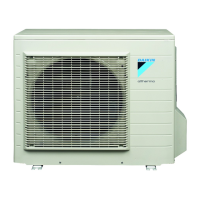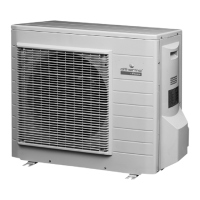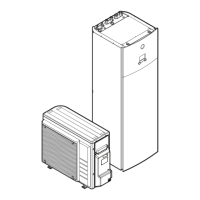Installation manual
15
ERHQ011~016BAV3+W1 + ERLQ011~016CAV3+W1
Outdoor unit for air to water heat pump
4PW57794-1 – 08.2010
9.3. Stop valve operation
Cautions on handling the stop valve
■ Make sure to keep both stop valves open during operation.
■ The figure below shows the name of each part required in
handling the stop valve.
■ The stop valve is factory closed.
■ Do not apply excessive force to the valve stem. Doing so may
break the valve body.
■ Since the stop valve attachment plate may be deformed if only a
torque wrench is used to loosen or tighten the flare nut, always
make sure to secure the stop valve with a spanner, then loosen
or tighten the flare nut with a torque wrench.
Do not place the spanner on the stem cap, as this could cause a
refrigerant leak.
■ When it is expected that the operating pressure will be low (for
example, when cooling will be performed while the outside air
temperature is low), sufficiently seal the flare nut in the stop
valve on the gas line with silicon sealant to prevent freezing.
Opening/closing the stop valve
Opening the stop valve
1. Remove the valve cover.
2. Insert a hexagon wrench (liquid side: 4 mm/gas side: 6 mm) into
the valve stem and turn the valve stem counterclockwise.
3. When the valve stem cannot be turned any further, stop turning.
The valve is now open.
Closing the stop valve
1. Remove the valve cover.
2. Insert a hexagon wrench (liquid side: 4 mm/gas side: 6 mm) into
the valve stem and turn the valve stem clockwise.
3. When the valve stem cannot be turned any further, stop turning.
The valve is now closed.
Cautions on handling the stem cap
■ The stem cap is sealed where
indicated by the arrow. Take care not
to damage it.
■ After handling the stop valve, make
sure to tighten the stem cap securely.
For the tightening torque, refer to the
table below.
■ Check for refrigerant leaks after tightening the stem cap.
Cautions on handling the service port
■ Always use a charge hose equipped with a valve depressor pin,
since the service port is a Schrader type valve.
■ After handling the service port, make sure to tighten the service
port cap securely. For the tightening torque, refer to the table
below.
■ Check for refrigerant leaks after tightening the service port cap.
9.4. Tightening torques
10. REFRIGERANT PIPING
■ Field pipes can be installed in four directions (A, B, C, D).
Figure - Field pipes in 4 directions
■ Cutting out the two slits makes it possible to install as shown in
the figure "Field pipes in 4 directions".
(Use a metal saw to cut out the slits.)
■ To install the connecting pipe to the unit in a downward direction,
make a knockout hole by penetrating the centre area around the
knockout hole using a Ø6 mm drill (4x). (See figure "Field pipes
in 4 directions".)
■ After knocking out the knockout hole, it is recommended to apply
repair paint to the edge and the surrounding end surfaces to
prevent rusting.
1 Spanner
2 Torque wrench
Silicon sealant
(Make sure there is no gap)
Closing direction
Liquid side Gas side
3
4
1
2
1 Service port and service port cap
2 Valve stem
3 Field piping connection
4 Stem cap
1
2
Item Tightening torque (N•m)
Stem cap, liquid side 13.5~16.5
Stem cap, gas side 22.5~27.5
Service port cap 11.5~13.9
1 Drill
2 Centre area around knockout hole
3 Knockout hole
4 Slit
5 Connecting pipe
6 Bottom frame
7 Front plate
8 Pipe outlet plate
9 Screw front plate
10 Pipe outlet plate screw
A Forward
B Backward
C Sideways
D Downward
44
321
8
7
9
10
A
D
C
B
56

